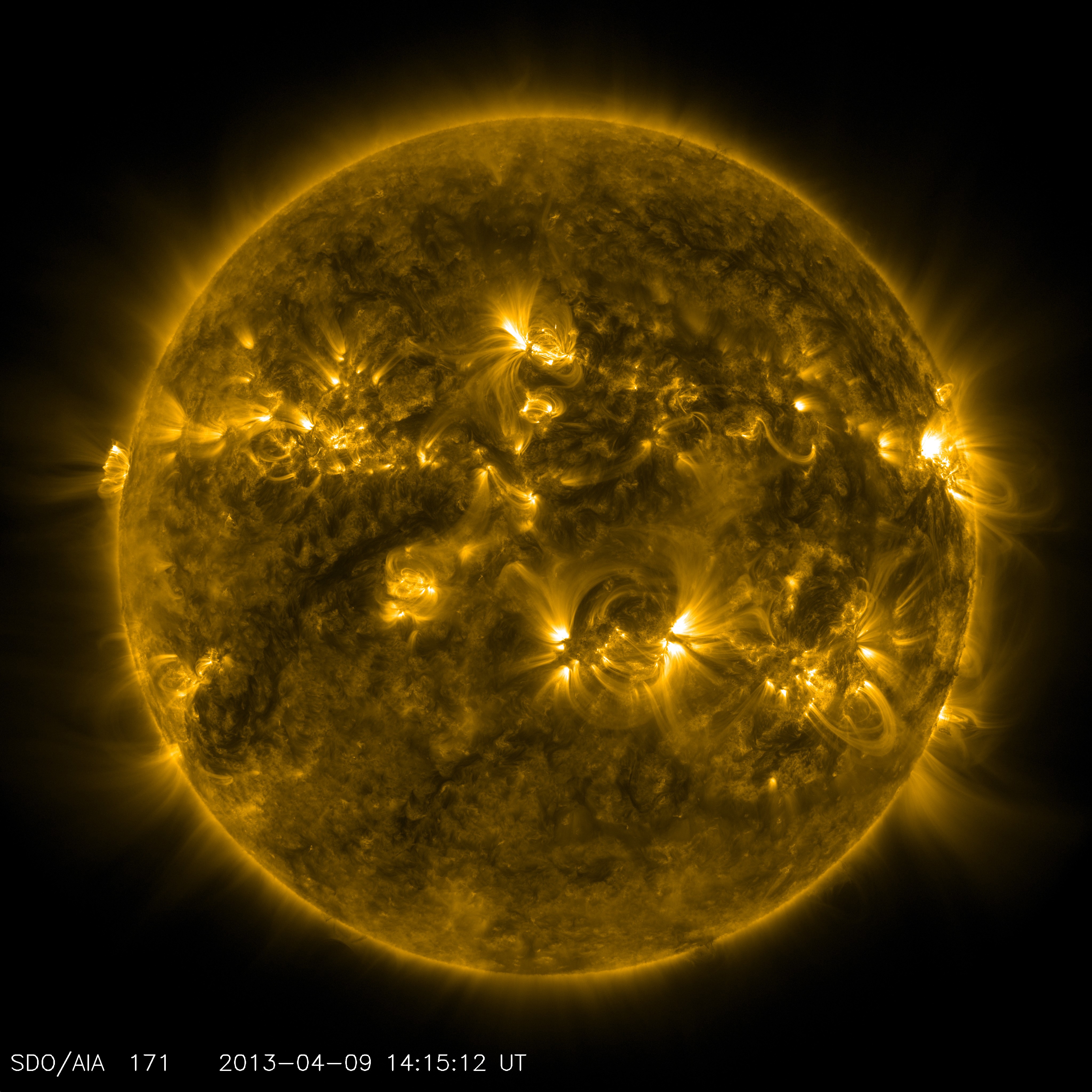|
Magnetohydrodynamics
In physics and engineering, magnetohydrodynamics (MHD; also called magneto-fluid dynamics or hydromagnetics) is a model of electrically conducting fluids that treats all interpenetrating particle species together as a single Continuum mechanics, continuous medium. It is primarily concerned with the low-frequency, large-scale, magnetic behavior in Plasma (physics), plasmas and liquid metals and has applications in multiple fields including space physics, geophysics, astrophysics, and engineering. The word ''magnetohydrodynamics'' is derived from ' meaning magnetic field, ' meaning water, and ' meaning movement. The field of MHD was initiated by Hannes Alfvén, for which he received the Nobel Prize in Physics in 1970. History The MHD description of electrically conducting fluids was first developed by Hannes Alfvén in a 1942 paper published in Nature (journal), ''Nature'' titled "Existence of Electromagnetic–Hydrodynamic Waves" which outlined his discovery ... [...More Info...] [...Related Items...] OR: [Wikipedia] [Google] [Baidu] [Amazon] |
Alfvén Wave
In plasma physics, an Alfvén wave, named after Hannes Alfvén, is a type of plasma wave in which ions oscillate in response to a restoring force provided by an Magnetic tension force, effective tension on the magnetic field lines. Definition An Alfvén wave is a low-frequency (compared to the ion gyrofrequency) travelling oscillation of the ions and magnetic field in a Plasma (physics), plasma. The ion mass density provides the inertia and the magnetic field line tension provides the restoring force. Alfvén waves propagate in the direction of the magnetic field, and the motion of the ions and the perturbation of the magnetic field are transverse to the direction of propagation. However, Alfvén waves existing at oblique incidences will smoothly change into magnetosonic waves when the propagation is perpendicular to the magnetic field. Alfvén waves are Dispersion relation, dispersionless. Alfvén velocity The low-frequency relative permittivity \varepsilon of a magnetized ... [...More Info...] [...Related Items...] OR: [Wikipedia] [Google] [Baidu] [Amazon] |
Hannes Alfvén
Hannes Olof Gösta Alfvén (; 30 May 1908 – 2 April 1995) was a Swedish electrical engineer, plasma physicist and winner of the 1970 Nobel Prize in Physics for his work on magnetohydrodynamics (MHD). He described the class of MHD waves now known as Alfvén waves. He was originally trained as an electrical power engineer and later moved to research and teaching in the fields of plasma physics and electrical engineering. Alfvén made many contributions to plasma physics, including theories describing the behavior of aurorae, the Van Allen radiation belts, the effect of magnetic storms on the Earth's magnetic field, the terrestrial magnetosphere, and the dynamics of plasmas in the Milky Way galaxy. Education Alfvén received his PhD from the University of Uppsala in 1934. His thesis was titled "Investigations of High-frequency Electromagnetic Waves." Early years In 1934, Alfvén taught physics at both the University of Uppsala and the Nobel Institute for Physics (lat ... [...More Info...] [...Related Items...] OR: [Wikipedia] [Google] [Baidu] [Amazon] |
Plasma (physics)
Plasma () is a state of matter characterized by the presence of a significant portion of charged particles in any combination of ions or electrons. It is the most abundant form of ordinary matter in the universe, mostly in stars (including the Sun), but also dominating the rarefied intracluster medium and Outer space#Intergalactic space, intergalactic medium. Plasma can be artificially generated, for example, by heating a neutral gas or subjecting it to a strong electromagnetic field. The presence of charged particles makes plasma electrically conductive, with the dynamics of individual particles and macroscopic plasma motion governed by collective electromagnetic fields and very sensitive to externally applied fields. The response of plasma to electromagnetic fields is used in many modern devices and technologies, such as plasma display, plasma televisions or plasma etching. Depending on temperature and density, a certain number of neutral particles may also be present, in wh ... [...More Info...] [...Related Items...] OR: [Wikipedia] [Google] [Baidu] [Amazon] |
Magnetic Field
A magnetic field (sometimes called B-field) is a physical field that describes the magnetic influence on moving electric charges, electric currents, and magnetic materials. A moving charge in a magnetic field experiences a force perpendicular to its own velocity and to the magnetic field. A permanent magnet's magnetic field pulls on ferromagnetic materials such as iron, and attracts or repels other magnets. In addition, a nonuniform magnetic field exerts minuscule forces on "nonmagnetic" materials by three other magnetic effects: paramagnetism, diamagnetism, and antiferromagnetism, although these forces are usually so small they can only be detected by laboratory equipment. Magnetic fields surround magnetized materials, electric currents, and electric fields varying in time. Since both strength and direction of a magnetic field may vary with location, it is described mathematically by a function (mathematics), function assigning a Euclidean vector, vector to each point of space, ... [...More Info...] [...Related Items...] OR: [Wikipedia] [Google] [Baidu] [Amazon] |
Center Of Mass
In physics, the center of mass of a distribution of mass in space (sometimes referred to as the barycenter or balance point) is the unique point at any given time where the weight function, weighted relative position (vector), position of the distributed mass sums to zero. For a rigid body containing its center of mass, this is the point to which a force may be applied to cause a linear acceleration without an angular acceleration. Calculations in mechanics are often simplified when formulated with respect to the center of mass. It is a hypothetical point where the entire mass of an object may be assumed to be concentrated to visualise its motion. In other words, the center of mass is the particle equivalent of a given object for application of Newton's laws of motion. In the case of a single rigid body, the center of mass is fixed in relation to the body, and if the body has uniform density, it will be located at the centroid. The center of mass may be located outside the Phys ... [...More Info...] [...Related Items...] OR: [Wikipedia] [Google] [Baidu] [Amazon] |
Continuity Equation
A continuity equation or transport equation is an equation that describes the transport of some quantity. It is particularly simple and powerful when applied to a conserved quantity, but it can be generalized to apply to any extensive quantity. Since mass, energy, momentum, electric charge and other natural quantities are conserved under their respective appropriate conditions, a variety of physical phenomena may be described using continuity equations. Continuity equations are a stronger, local form of conservation laws. For example, a weak version of the law of conservation of energy states that energy can neither be created nor destroyed—i.e., the total amount of energy in the universe is fixed. This statement does not rule out the possibility that a quantity of energy could disappear from one point while simultaneously appearing at another point. A stronger statement is that energy is ''locally'' conserved: energy can neither be created nor destroyed, ''nor'' can it ... [...More Info...] [...Related Items...] OR: [Wikipedia] [Google] [Baidu] [Amazon] |
Cauchy Momentum Equation
The Cauchy momentum equation is a vector partial differential equation put forth by Augustin-Louis Cauchy that describes the non-relativistic momentum transport in any continuum. Main equation In convective (or Lagrangian) form the Cauchy momentum equation is written as: \frac = \frac 1 \rho \nabla \cdot \boldsymbol + \mathbf where * \mathbf is the flow velocity vector field, which depends on time and space, (unit: \mathrm) * t is time, (unit: \mathrm) * \frac is the material derivative of \mathbf, equal to \partial_t\mathbf + \mathbf\cdot \nabla\mathbf, (unit: \mathrm) * \rho is the density at a given point of the continuum (for which the continuity equation holds), (unit: \mathrm) * \boldsymbol is the stress tensor, (unit: \mathrm) * \mathbf=\beginf_x\\ f_y\\ f_z\end is a vector containing all of the accelerations caused by body forces (sometimes simply gravitational acceleration), (unit: \mathrm) * \nabla\cdot\boldsymbol= \begin \dfrac + \dfrac + \dfrac \\ \dfrac + \dfra ... [...More Info...] [...Related Items...] OR: [Wikipedia] [Google] [Baidu] [Amazon] |
The Sun Is An MHD System That Is Not Well Understood- 2013-04-9 14-29
''The'' is a grammatical article in English, denoting nouns that are already or about to be mentioned, under discussion, implied or otherwise presumed familiar to listeners, readers, or speakers. It is the definite article in English. ''The'' is the most frequently used word in the English language; studies and analyses of texts have found it to account for seven percent of all printed English-language words. It is derived from gendered articles in Old English which combined in Middle English and now has a single form used with nouns of any gender. The word can be used with both singular and plural nouns, and with a noun that starts with any letter. This is different from many other languages, which have different forms of the definite article for different genders or numbers. Pronunciation In most dialects, "the" is pronounced as (with the voiced dental fricative followed by a schwa) when followed by a consonant sound, and as (homophone of the archaic pronoun ''thee' ... [...More Info...] [...Related Items...] OR: [Wikipedia] [Google] [Baidu] [Amazon] |
Equation Of State
In physics and chemistry, an equation of state is a thermodynamic equation relating state variables, which describe the state of matter under a given set of physical conditions, such as pressure, volume, temperature, or internal energy. Most modern equations of state are formulated in the Helmholtz free energy. Equations of state are useful in describing the properties of pure substances and mixtures in liquids, gases, and solid states as well as the state of matter in the interior of stars. Though there are many equations of state, none accurately predicts properties of substances under all conditions. The quest for a universal equation of state has spanned three centuries. Overview At present, there is no single equation of state that accurately predicts the properties of all substances under all conditions. An example of an equation of state correlates densities of gases and liquids to temperatures and pressures, known as the ideal gas law, which is roughly accurate ... [...More Info...] [...Related Items...] OR: [Wikipedia] [Google] [Baidu] [Amazon] |




